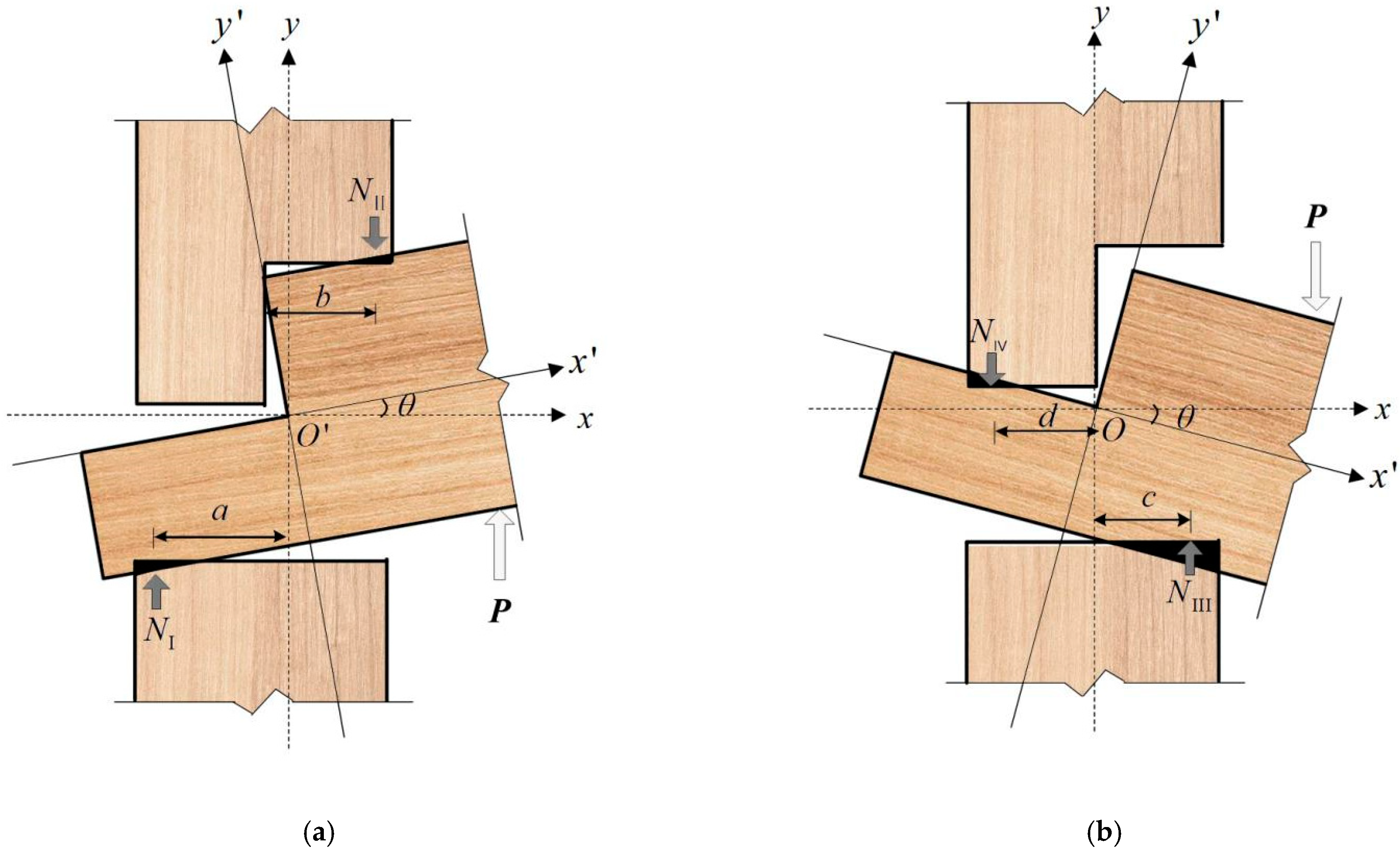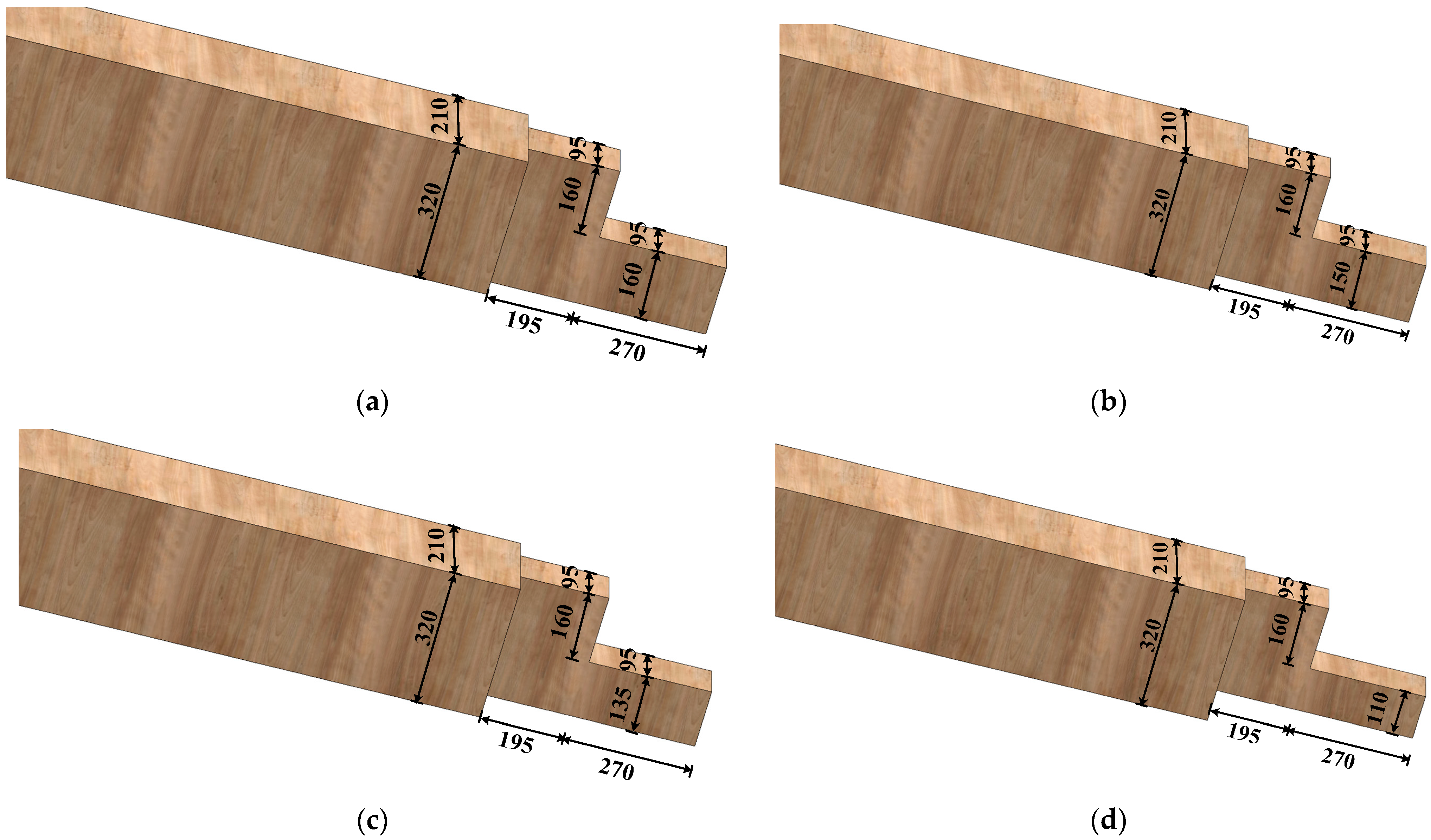Mechanical Behaviour and Failure Mode Analysis of Penetrated Mortise–Tenon Joint with Neighbouring Gaps Based on Full-Scale Experiments
Abstract
:1. Introduction
2. Method
2.1. Survey of the Statistical Distribution of Joint Gaps
2.2. Experimental Study
2.2.1. Configurations of the Joints
2.2.2. Working Mechanics
2.3. Test Specimens
2.4. Test Setup and Loading Programme
3. Results
3.1. Experimental Phenomena
3.2. Hysteretic Curve
3.3. Skeleton Curve
3.4. The Degradation Curve of the Rotation Stiffness
3.5. Energy Dissipation
4. Discussion Statement
4.1. Limited Gap Value of Loose Joint
4.2. The Simplified Restoring Moment Model
4.3. Stress State of the Loose Joint
5. Conclusions
- (1)
- The gap is primarily distributed within the 5–15 mm range, the proportion of joint with this gap value reaches 44%. Four typical gap values including 5 mm, 10 mm, 25 mm and 50 mm are selected to study the effects of the gap on the mechanical properties of the PMT joint;
- (2)
- The loose joint slips firstly when subjected to repeated loads. Once the tenon overcomes the free rotation angle, the mortise and tenon compress together. The predominant deformation of the joint is the partial pulling out of the tenon, and the contact portion between mortise and tenon has noticeable compression deformation. The failure stage is characterised by wood fibre tearing at the variable cross-section of the tenon at the negative loading. No obvious compression deformation of the column, fang and mortise occurs;
- (3)
- The hysteresis curve of restoring moment and rotational angle of LJ-1 and LJ-2 is an inverse “Z” shape with obvious pinching effect and the hysteresis loop is asymmetrical. The mortise–tenon joint undergoes slipping, elastic, strengthening and the failure stage in order. Hysteresis curves of the restoring moment and rotational angle of LJ-3 and LJ-4 are shriveled and the sliding length is longer than that of LJ-1 and LJ-2. It is worth noting that mortise–tenon joints mainly rely on compression force to resist external load and friction force to consume energy;
- (4)
- The bending bearing capacity and rotational stiffness of loose joints have a certain drop with the increase in gap. The limit angle of the loose joint lags behind that of the regular joint. The rotational stiffness of a loose joint with a large gap is essentially zero during loading, indicating that the mortise–tenon joint has almost no resisting capability. Because its stiffness is low, an acceptable processing method is required to improve the joint’s rotational performance under loose conditions. The limitation gap value is given, which can provide a reference to the protection and repair of the traditional timber structure. The proposed three-parameter power function model is noted to be consistent with experimental results, which shows that the proposed model can reflect the mechanical behaviour of joints;
- (5)
- The stress states of penetrated mortise–tenon joints with different loose conditions are discussed. Compression deformations are mainly located at the tenon. The smaller the degree of loosening, the greater the stress of the component. If the degree of loosening is large, the stress of joint is very small, indicating that the joint has almost no resistance to external load.
Author Contributions
Funding
Institutional Review Board Statement
Informed Consent Statement
Data Availability Statement
Acknowledgments
Conflicts of Interest
References
- Eckelman, C.A.; Haviarova, E. Rectangular mortise and full width tenon joints in ready-to-assemble light-frame timber constructions. Wood Fiber Sci. 2011, 43, 346–352. [Google Scholar]
- Pan, Y.; Wang, C.; Tang, L.N.; Li, L.J. Study on mechanical model of straight tenon joints in ancient timber structures. Eng. Mech. 2015, 32, 82–89. (In Chinese) [Google Scholar]
- Xie, Q.F.; D, B.; Zhang, F.L.; Zheng, P.J.; Xu, Q.F. Theoretical analysis on moment-rotation relationship of dovetail joints for Chinese ancient timber structure buildings. Eng. Mech. 2014, 31, 140–146. (In Chinese) [Google Scholar]
- Chen, C.C.; Qiu, H.X.; Lu, Y. Flexural behaviour of timber dovetail mortise–tenon joints. Constr. Build. Mater. 2016, 112, 366–377. [Google Scholar] [CrossRef] [Green Version]
- Jiang, S.F.; Wu, M.H.; Ma, S.L.; Lin, D.Y. Structural stiffness identification of traditional mortise-tenon joints based on statistical process control chart. J. Aerosp. Eng. 2018, 31, 66–77. [Google Scholar] [CrossRef]
- Shanks, J.; Walker, P. Testing of traditional connections in green oak carpentry. In Proceedings of the 8th World Conference of Timber Engineering, Lahti, Finland, 14–17 June 2004; pp. 183–186. [Google Scholar]
- Seo, J.M.; Choi, I.K.; Lee, J.R. Static and cyclic behaviour of wooden frames with tension joints under lateral load. J. Struct. Eng. 1999, 125, 344–349. [Google Scholar] [CrossRef]
- Han, S.R.; Lee, J.J. Mechanical performance of Korean traditional wooden building of the column-girder tenon-joint by joint type. In Proceedings of the 9th World Conference on Timber Engineering (WCTE 2006), Portland, OR, USA, 6–10 August 2006; p. 23. [Google Scholar]
- Suzuki, Y.; Maeno, M. Structural mechanism of traditional wooden frame by dynamic and static tests. Struct. Control Health Monit. 2006, 13, 508–552. [Google Scholar] [CrossRef]
- Chang, W.S. Research on Rotational Performance of Traditional Chuan-Dou Timber Joints in Taiwan. Ph.D. Dissertation, Chen Kung University, Tainan, China, 2006. [Google Scholar]
- Chun, Q.; Yue, Z.; Pan, J.W. Experimental study on seismic characteristics of typical mortise-tenon joints of Chinese southern traditional timber frame buildings. Sci. China Technol. Sci. 2011, 54, 2404–2411. [Google Scholar] [CrossRef]
- Chen, L.K.; Li, S.C.; Wang, Y.T.; Zhao, Y.J.; Zhang, M.; Song, X.Y.; Li, X.W.; Wu, T.; Jiang, L.Z. Experimental study on the seismic behaviour of mortise-tenon joints of the ancient timbers. Struct. Eng. Int. 2017, 27, 512–519. [Google Scholar] [CrossRef]
- Hou, J. Research and Analysis on the performance of tenon mortise joint with traditional structure based on finite element technology. Master’s Thesis, Taiyuan University of Technology, Taiyuan, China, 2016. [Google Scholar]
- King, W.S.; Yen, J.Y.R.; Yen, Y.N.A. Joint characteristics of traditional Chinese wooden frames. Eng. Struct. 1996, 18, 635–644. [Google Scholar] [CrossRef]
- Xie, Q.F.; Wang, L.; Zheng, P.J.; Zhang, L.; Hu, W. Rotational behaviour of degraded traditional mortise-tenon joints: Experimental tests and hysteretic model. Int. J. Archit. Herit. 2018, 12, 125–136. [Google Scholar] [CrossRef]
- Xue, J.Y.; Bai, F.Y.; Qi, L.J.; Sui, Y.; Zhou, C. Research on damage and identification of mortise-tenon joints stiffness in ancient wooden buildings based on shaking table test. Struct. Eng. Mech. 2018, 65, 547–556. [Google Scholar] [CrossRef]
- Li, Y.Z.; Cao, S.Y.; Xue, J.Y. Analysis on mechanical behaviour of dovetail mortise-tenon joints with looseness in traditional timber buildings. Struct. Eng. Mech. 2016, 60, 903–921. [Google Scholar] [CrossRef]
- Chang, W.S.; Hsu, M.F.; Komatsu, K. Rotational performance of traditional Nuki joints with gap I: Theory and verification. J. Wood Sci. 2006, 52, 58–62. [Google Scholar] [CrossRef]
- Chang, W.S.; Hsu, M.F. Rotational performance of traditional Nuki joints with gap II: The behaviour of butted Nuki joint and its comparison with continuous Nuki joint. J. Wood Sci. 2007, 53, 401–407. [Google Scholar] [CrossRef]
- Ogawa, K.; Sasaki, Y.; Yamasaki, M. Theoretical estimation of the mechanical performance of traditional mortise-tenon joint involving a gap. J. Wood Sci. 2016, 62, 242–250. [Google Scholar] [CrossRef] [Green Version]
- Zhang, L. Experimental Study on the Mechanical Properties of Wood and the Numerical Modeling Strategies of Wood. Master’s Dissertation, Beijing Jiaotong University, Beijing, China, 2017. [Google Scholar]
- GB/T 1935-2009; State Forestry Administration of the People’s Republic of China Test Method for Compressive Strength along Grain of Wood. China Standards Press: Beijing, China, 2009.
- GB/T 1943-2009; State Forestry Administration of the People’s Republic of China Determination Method of Transverse Compressive Elastic Modulus of Wood. China Standards Press: Beijing, China, 2009.
- ISO-16670; Timber Structures: Joints Made with Mechanical Fasteners: Qusai-Static Reversed-Cyclic Test Method. International Organization for Standardization: Geneva, Switzerland, 2003.
- Xie, Q.F.; Zhang, L.P.; Li, S. Cyclic behaviour of Chinese ancient wooden frame with mortise-tenon joints: Friction constitutive model and finite element modelling. J. Wood. Sci. 2018, 64, 40–51. [Google Scholar] [CrossRef] [Green Version]
- GB 50165-92; Technical Code for Maintenance and Strengthening of ANCIENT timber Buildings. China Construction Industry Press: Beijing, China, 1992.
- He, J.X.; Wang, J.; Yang, Q.S.; Han, M. Study on mechanical behaviours of loose mortise-tenon joint with neighbouring gap. Struct. Eng. Mech. 2021, 77, 509–521. [Google Scholar] [CrossRef]
- Wan, J. Static and Dynamic FE Analyses of Single Column Frictional System in the 3rd and 7th Ts’ai Recording in Yingzaofashi. Master’s Dissertation, Taiyuan University of Technology, Taiyuan, China, 2015. [Google Scholar]
































| 8.856 MPa | 34.76 MPa | 0.3 | 1024 MPa | 4.18 MPa | 0.19 |
| LJ-1 | LJ-2 | LJ-3 | LJ-4 | |
|---|---|---|---|---|
| 0.00924 | 0.02322 | 0.05093 | 0.05556 | |
| −0.0046 | −0.02167 | −0.06022 | −0.0926 | |
| 17.41693 | 14.19 | 7.77717 | 5.15699 | |
| −15.9156 | −13.3875 | −6.79473 | −1.59156 | |
| - | 18.5% | 55.4% | 70.4% | |
| - | 15.9% | 57.3% | 90% |
| Global Inclination | Horizontal displacement | and |
| Local Inclination | The relative displacement of the top and bottom of the column | and |
| Global Inclination | , and |
| Local Inclination | and |
| LJ-1 | LJ-2 | LJ-3 | LJ-4 | |
|---|---|---|---|---|
| (MPa) | 4.18 | 4.18 | 3.25 | 0.84 |
| (MPa) | 4.18 | 4.18 | 1.539 | 0.84 |
Publisher’s Note: MDPI stays neutral with regard to jurisdictional claims in published maps and institutional affiliations. |
© 2022 by the authors. Licensee MDPI, Basel, Switzerland. This article is an open access article distributed under the terms and conditions of the Creative Commons Attribution (CC BY) license (https://creativecommons.org/licenses/by/4.0/).
Share and Cite
Wang, J.; He, J.-X.; Yuan, Y.-J.; Yang, N. Mechanical Behaviour and Failure Mode Analysis of Penetrated Mortise–Tenon Joint with Neighbouring Gaps Based on Full-Scale Experiments. Appl. Sci. 2022, 12, 7164. https://doi.org/10.3390/app12147164
Wang J, He J-X, Yuan Y-J, Yang N. Mechanical Behaviour and Failure Mode Analysis of Penetrated Mortise–Tenon Joint with Neighbouring Gaps Based on Full-Scale Experiments. Applied Sciences. 2022; 12(14):7164. https://doi.org/10.3390/app12147164
Chicago/Turabian StyleWang, Juan, Jun-Xiao He, Yu-Jing Yuan, and Na Yang. 2022. "Mechanical Behaviour and Failure Mode Analysis of Penetrated Mortise–Tenon Joint with Neighbouring Gaps Based on Full-Scale Experiments" Applied Sciences 12, no. 14: 7164. https://doi.org/10.3390/app12147164
APA StyleWang, J., He, J.-X., Yuan, Y.-J., & Yang, N. (2022). Mechanical Behaviour and Failure Mode Analysis of Penetrated Mortise–Tenon Joint with Neighbouring Gaps Based on Full-Scale Experiments. Applied Sciences, 12(14), 7164. https://doi.org/10.3390/app12147164






